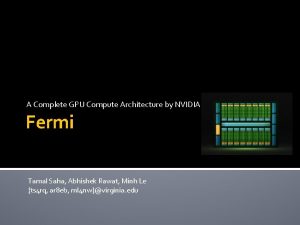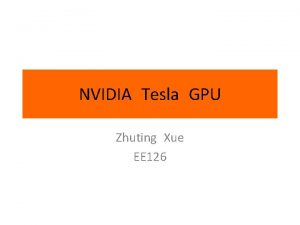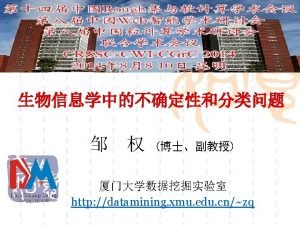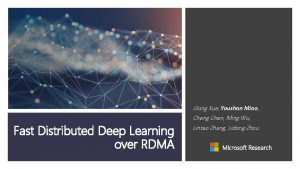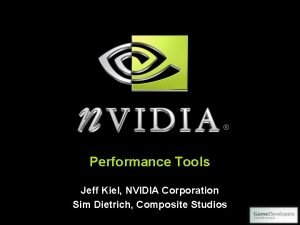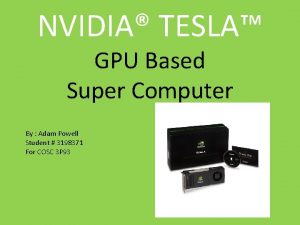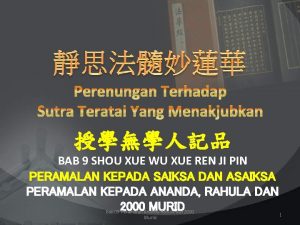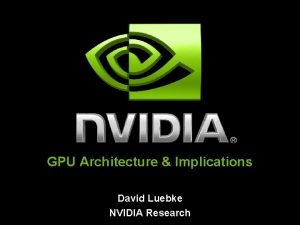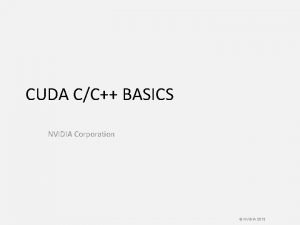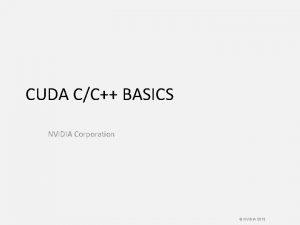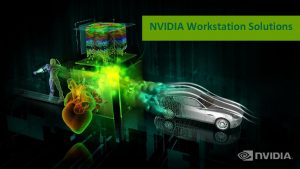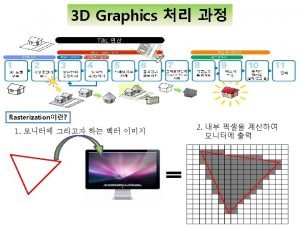NVIDIA Tesla GPU Zhuting Xue EE 126 GPU









![Reference [1]Maciol, Pawel, and Krzysztof Banas. "Testing tesla architecture for scientific computing: The performance Reference [1]Maciol, Pawel, and Krzysztof Banas. "Testing tesla architecture for scientific computing: The performance](https://slidetodoc.com/presentation_image_h2/c59eac865f41d20d2de502ef75875f4b/image-10.jpg)
- Slides: 10

NVIDIA Tesla GPU Zhuting Xue EE 126

GPU Graphics Processing Unit The "brain" of graphics, which determines the quality of performance of the graphics

NVIDIA Tesla NVIDIA is a company, which designs graphics chip and chipset-based semiconductor , also achieving a lot of breakthroughs in parallel processing. Tesla is a GPU produced by NVIDIA, which is designed for large-scale parallel computer; mostly work for science research in labs.

GPU & CPU In NVIDIA’s design, the GPU cooperates with CPU to accelerate scientific and other applications. Compute-Intensive Functions 5% of code GPU Rest of Sequential CPU Code 95% of code Application Code CPU

GPU Architecture Dynamic Parallelism All child launches must complete in order for the parent kernel to be seen as completed Recursion, irregular loop structure or other structures that do not fit a flat, singlelevel parallelism can be more transparently expressed. CPU A X B Y C Z

GPU Architecture Host interface and Compute Work Distribution Getting instructions and data from the host CPU and its main memory; also manage threads of execution by assigning groups of threads to processor clusters and performing context switching; TPC Bridge (Streaming Multiprocessor) A part of TPC, consisting of eight streaming processor cores, two special function units (for performing interpolation and approximate evaluation of trigonometric functions, logarithms, etc. ), a multithreaded instruction fetch and issue unit, two caches and a pool of shared memory; Texture unit Each unit is shared by two SMs, the unit plays its part in graphics calculations and is equipped with L 1 cache memory accessible from SPs; Level 2 Cache memory units are connected through fast network to TPCs. System Memory GPU Host Interface Input Assembler viewport/clip/setu p/raster/zcull Vertex Work Distribution Pixel Work Distribution (texture/processor cluster) A basic building block of Tesla architecture GPUs (a single GPU can have from one to eight TPCs); SM Host CPU TPC Compute Work Distribution TPC SM SM SP SP Shared Memory Shared Memory Text Unit Interconnection Network ROP DRAM L 2

GPU Challenges • The GPU remains a specialized processor • Its performance in graphics computation belies a host of difficulties to perform true general-purpose computing. • The processors themselves require recompiling software they have rudimentary programming tools, as well as limits in programming languages and features.

GPU VS CPU VS GPU

Conclusion • GPU still cooperates with CPU , which is supposed to be broken through so that the GPU can complete all work without the help of CPU. • The competition between CPU and GPU is positive, which leads to the development of both GPU and CPU.
![Reference 1Maciol Pawel and Krzysztof Banas Testing tesla architecture for scientific computing The performance Reference [1]Maciol, Pawel, and Krzysztof Banas. "Testing tesla architecture for scientific computing: The performance](https://slidetodoc.com/presentation_image_h2/c59eac865f41d20d2de502ef75875f4b/image-10.jpg)
Reference [1]Maciol, Pawel, and Krzysztof Banas. "Testing tesla architecture for scientific computing: The performance of matrix-vector product. " Computer Science and Information Technology, 2008. IMCSIT 2008. International Multiconference on. IEEE, 2008. [2]Andreyev, A. Sitek, and A. Celler. "Acceleration of blob-based iterative reconstruction algorithm using Tesla GPU. " Nuclear Science Symposium Conference Record (NSS/MIC), 2009 IEEE, 2009. [3]Lindholm, Erik, et al. "NVIDIA Tesla: A unified graphics and computing architecture. " Ieee Micro 28. 2 (2008): 39 -55. [4]Heinecke, Alexander. "Accelerators in scientific computing is it worth the effort? . " High Performance Computing and Simulation (HPCS), 2013 International Conference on. IEEE, 2013.
